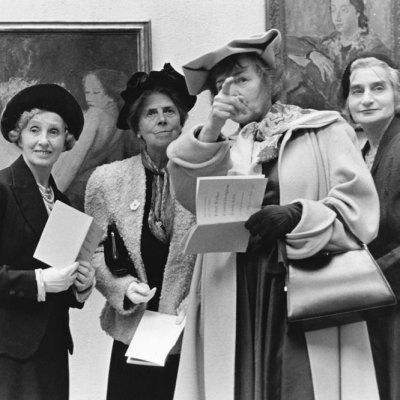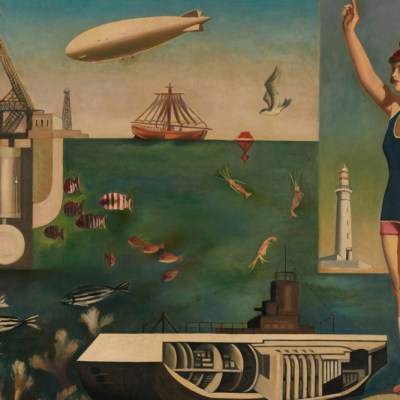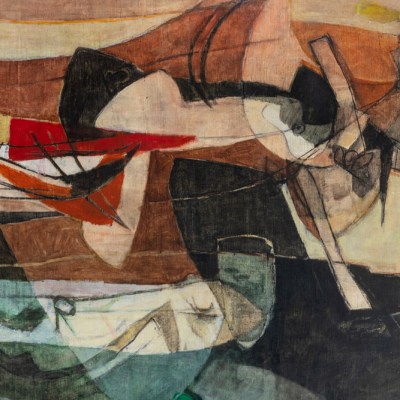From the October 2022 issue of Apollo. Preview and subscribe here.
Arshile Gorky twice painted a portrait of his childhood self standing next to his seated mother. Both are based on a photograph that the artist found shortly after he had arrived in the United States, and after his mother, a victim of the Armenian genocide, had died in his arms. It’s not known why he painted it twice, nor which was started first. So, do we say that one is a copy of the other? A repetition of it? A cancelling? A restatement? Or something else entirely? Is it, to borrow the title of this speculative show at the National Gallery of Art in Washington, D.C., a ‘double’? With so much unknown, the word ‘version’ seems most adequate, even if it’s non-committal. That word springs to mind again and again while viewing ‘The Double’, even if the curator, James Meyer, wants to persuade us of different terms.
The contemporary United States is a house so divided that it is a marvel that it is still standing. In addressing the crisis, one can see the attractions of a show about pairs, splits and opposition. Resting in the shadow of the US Capitol, the NGA likely feels an obligation to make that speech; the show’s subtitle, speaking of ‘identity and difference’, signals its ambition to go beyond mere party politics and into far boggier terrain. It’s all very contentiously ambitious, and that might explain why the show opens with two works that are both predictable and offer little ground for disagreement: Jasper Johns’ Two Flags (1962) and Glenn Ligon’s Double America (2012), a doubled neon with complexly mirrored text, white on top, black on the bottom. After that, however, things swiftly turn more digressive, conceptual and mostly apolitical.
The Artist and his Mother (c. 1926–c. 1942), Arshile Gorky. National Gallery of Art, Washington, D.C.

The show proclaims to reach back to 1900, but after some opening salvos, of which Gorky’s two versions of The Artist and His Mother (the Whitney Museum’s version dated c. 1926–36; the version at the NGA dated c. 1926–c. 1942) are key, most of the work is post-1960. The imbalance is a shame because the break with modernism is one area where the premise of the show seems to have art-historical arguments. Rauschenberg’s Factum I and Factum II (both 1957) are textbook refutations of the Ab-Ex ideology of hot spontaneity, with one work being a near perfect copy of the other, instinctive painterly gestures and all. Warhol’s Ambulance Disaster (1963–64) performs a similar cooling, with doubling used to mute the trauma of the wreck, or magnify it, or otherwise mediate it, depending on your view. And Robert Smithson’s Enantiomorphic Chambers (1965), a contraption that serves to split and confound binocular vision, shows the artist’s typically brainy attack on the contemporary formalist stress on unities.
The attacks on modernist originality that stepped up in the 1980s are also well illuminated by the theme, and to highlight these there is Sherrie Levine’s After Walker Evans 4 (1981), paired with the work that inspired it, Evans’ Allie Mae Burroughs, Hale County, Alabama (1936). There is a section entitled ‘Seeing Double’ that offers what I’ll call pairs of versions; a section on ‘reversal’ in which objects are variously mirrored, or in the case of two photographic works by Man Ray, displayed as both positive and negative; a section on ‘dilemma’ which includes brilliant formal puzzles such as Frank Stella’s Jasper’s Dilemma (1962–63) in which areas of colour and grisaille are somehow separated yet oddly integrated; and finally a section on ‘the doubled and divided self’.
The Artist and his Mother (c. 1926–36), Arshile Gorky. Whitney Museum of American Art, New York. Photo: © Whitney Museum of American Art/Licensed by Scala/Art Resource, NY

There is much argument here, but ultimately ‘Doubles’ is a more parlour game than tutorial, notwithstanding the presence of an academic heavyweight like W.J.T. Mitchell in the substantial catalogue. One apparent benefit of this is a digressiveness and a rich eclecticism in the show’s selections, with unsung works getting equal billing with the canon. Among the surprises is a gouache by Sylvia Plath, a drawing by Guy de Cointet, and, by Barbara Probst, a pair of photographic double-portraits (double deuce!). Not surprisingly, photography supplies some of the clearest and most charming arguments. And in general we are charmed rather than deeply swayed. ‘Doubles’ is certainly not ‘L’informe: Mode d’emploi’, the academic and museological landmark staged by Rosalind Krauss and Yve-Alain Bois at the Pompidou in 1996. That show explored Georges Bataille’s concept of the informe, one which threatens to abolish categories – binaries and all.
By contrast, James Meyer’s show doubles down on the double, and it feels retardataire, out of step not only with theory but also with contemporary debate around gender and sexuality, in which binaries are now viewed as prisons of conformity. Out of step with the heat of that debate, too: identity politics has made once simple pronoun choices into ‘dilemmas’ with some very sharp horns. ‘Doubles’ does speak to these issues, but it does so largely in a section on the ‘doubled or divided self’, a category that hardly captures contemporary notions of fluid identity. The final room then presents a series of work by Gilbert & George, Felix Gonzalez-Torres, Roni Horn and others (the latter with a tribute to Gonzalez-Torres and his lover, Ross) in which the notion of ‘The Pair’ is said to have a quality of queerness. That’s an idea that might strike heterosexual couples as queer in a rather different way.
But if I began the show in disagreement over Gorky, and ended in disagreement about the likes of Gilbert & George, I found myself later wandering the NGA’s permanent collections and being struck anew by doubles; in particular by Monet’s The Seine at Giverny, sadly ruled out perhaps by being painted in 1897, but in which the trees’ reflections on the shimmering water create a doubling that is also a singling, a unifying of the picture plane. If seeing ‘Doubles’ does anything, it makes you see doubles.
‘The Double: Identity and Difference in Art since 1900’ is at the National Gallery of Art, Washington, D.C. until 31 October.
From the October 2022 issue of Apollo. Preview and subscribe here.



